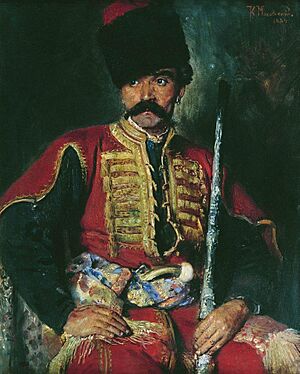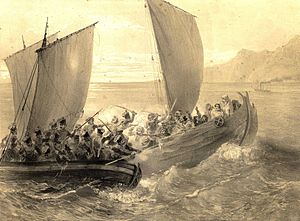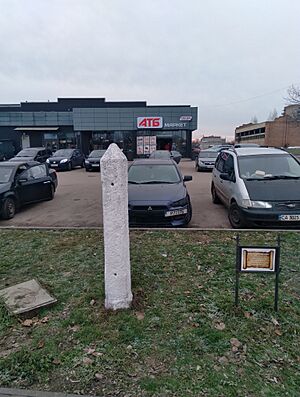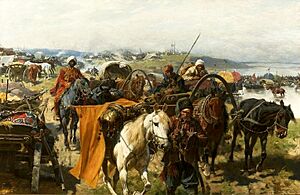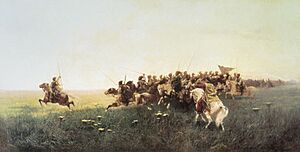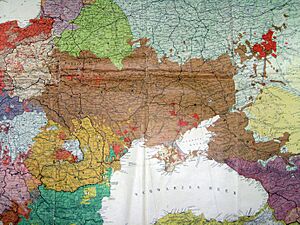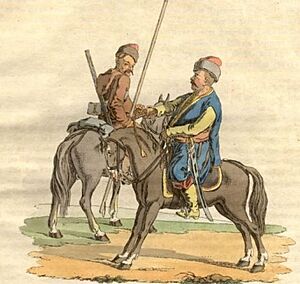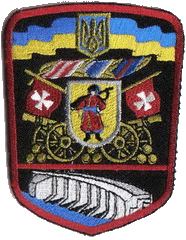Zaporozhian Cossacks facts for kids
The Zaporozhian Cossacks were a special group of Cossacks who lived in Ukraine, south of the Dnieper River rapids. They were also known as the Zaporozhian Host or simply Zaporozhians. These brave people played a big part in the history of Ukraine and helped shape the Ukrainians as a people.
Their main home was the Zaporozhian Sich, which grew quickly in the 1400s. Many people, especially serfs (farmers tied to the land) who were escaping tough lives in the Polish–Lithuanian Commonwealth, joined them. The Sich became a respected place with its own government, almost like a small republic. For over 200 years, the Zaporozhian Cossacks were a strong military and political power. They often challenged the Polish–Lithuanian Commonwealth, the Tsardom of Russia, and the Crimean Khanate.
The Cossacks were involved in many fights and made different alliances with these powers. Eventually, in the late 1700s, the Russian Empire broke up their group by force. Many Cossacks were moved to the Kuban region in southern Russia. Others started new cities in southern Ukraine. The Cossacks were important in helping Russia expand its territory. In return, the Tsars (Russian emperors) gave them a lot of freedom.
The name "Zaporozhtsi" comes from their fortress, the Zaporozhian Sich. It means "land beyond the rapids" in Ukrainian. This describes their location beyond the Dnieper River's fast-flowing parts.
Contents
Where Did the Zaporozhian Cossacks Come From?
It's not fully clear when the first Cossack groups formed near the Dnieper River. There are stories of similar free people living in the Eurasian Steppe as early as the 1100s. Back then, they weren't called Cossacks. The word "Cossack" comes from a Turkic word meaning "free man." It later became a Ukrainian and Russian word for a "freebooter" or adventurer.
The wild lands north of the Black Sea were home to traveling tribes. Some people from Kievan Rus' (an early East Slavic state) also ran away to these steppes. They wanted to escape difficult lives or problems. Their way of life was much like the later Cossacks. They mostly hunted, fished, and sometimes raided other tribes for horses and food. They also mixed with these traveling groups and adopted some of their customs. In the 1500s, a Ukrainian nobleman named Dmytro Vyshnevetsky brought these different groups together. He turned them into a strong military force.
The Zaporozhian Cossacks came from many different backgrounds. Most were farmers who had escaped from being tied to the land. They preferred the dangerous freedom of the wild steppes over living under Polish nobles. But townspeople, lesser nobles, and even Crimean Tatars also joined the Cossacks. Everyone had to become Eastern Orthodox Christians and follow their traditions.
Life with the Polish-Lithuanian Commonwealth
In the 1500s, the Polish–Lithuanian Commonwealth became very powerful. They saw the Zaporozhian Cossacks as their subjects, but the Cossacks were very independent. Some Cossacks, called Registered Cossacks, even served in the Commonwealth army until 1699.
Towards the end of the 1500s, the Cossacks started raiding lands belonging to the Ottoman Empire. This made relations between the Commonwealth and the Ottomans much worse. The Polish government couldn't control the Cossacks. But since the Cossacks were supposedly part of the Commonwealth, Poland was blamed for the raids. In return, the Tatars, who lived under Ottoman rule, raided Polish lands. However, Cossacks often attacked rich port cities deep inside the Ottoman Empire. These cities were only a two-day boat trip from the Dnieper River.
By 1615 and 1625, Cossacks even attacked areas near Constantinople, the Ottoman capital. This forced the Ottoman Sultan Murad IV to flee his palace. Later, Sultan Mehmed IV received a famous, very rude letter from the Zaporozhian Cossacks. He had demanded they surrender to him. Treaties between the Ottomans and Poland tried to stop these raids. But neither side could fully control their fighters. The Cossacks agreed to burn their boats, but they could rebuild them quickly. Raiding and taking loot were a big part of the Cossack way of life.
The number of Cossacks grew as Ukrainian farmers escaped from being serfs in Poland. The Polish nobles tried to make the Zaporozhian Cossacks into serfs too. This made the Cossacks less loyal to the Commonwealth. The Cossacks wanted to be seen as equals to the nobles, but this rarely happened. They also wanted to create a "Polish–Lithuanian–Ruthenian Commonwealth" that included the Ukrainian Cossacks. But this idea didn't go far because the Cossacks were not popular with the nobles.
The Cossacks were strong followers of the Eastern Orthodox Church. This caused problems with the Commonwealth, which was mostly Catholic. When the Commonwealth started to suppress the Orthodox church, the Cossacks became very anti-Catholic, which meant they were also anti-Polish.
These tensions led to several Cossack uprisings against the Polish–Lithuanian Commonwealth in the early 1600s. The biggest and most successful was the Khmelnytsky Uprising, which began in 1648. The Polish King refused to let more Cossacks join the official Cossack Registry. This was the final straw. This uprising was a major disaster for the Commonwealth. It greatly weakened Poland and led to its breakup later. Poland had strong cavalry, but the Ukrainian Cossacks had some of the best infantry in Europe. When Ukraine became free from Polish rule, the Commonwealth's army suffered a lot.
How the Zaporozhian Cossacks Were Organized
The Zaporozhian Host was a military and political group with its own unique rules and traditions, called the Cossack Code. It had a military and administrative system. There were 38 kurins (like companies) and five to eight palankas (territorial districts). They also had a special system of leaders. All officers were chosen by the General Military Council every year on January 1. Their rights and duties were clearly written down. The Zaporozhian Host also had its own court system, based on the Cossack Code. Some people even called the Zaporozhian Sich a "Cossack republic." This is because all members had a say, and their leaders were elected.
The main leader of the Zaporozhian Host was never officially called a hetman. But all Cossack leaders were often unofficially called that. The highest governing body was the Sich Rada (council). This council made all the laws, managed the group, and handled justice. Its decisions were seen as the will of the entire Host. The Sich Rada discussed internal and foreign policies. It also elected officers, divided land, and punished serious criminals.
The Zaporozhian Host was closely connected to the Cossack Hetmanate but had its own rules. For military actions, Cossacks formed a Kish. This was an old word for a strong camp. The Kish was the main government body in the Sich. It handled administration, military, money, and legal matters. The Kish was elected every year at the Sich Rada, which was a council of all Cossacks. Elections happened on January 1, October 1, or the second or third day of Easter.
The Cossacks had a military court that strictly punished violence and stealing among their own people. They also had churches and schools. These provided religious services and basic education. The Eastern Orthodox Church was very important to their identity.
When there was no fighting, Cossacks worked in their jobs and lived with their families. They also studied military strategies, languages, and trained new recruits. Unlike other armies, Cossacks could choose their own weapons. Rich Cossacks often wore heavy armour. Foot soldiers usually wore simple clothes, but sometimes wore chainmail.
At that time, the Cossacks were one of the best military groups in Europe. They were hired by the Russian, Polish, and French empires.
Cossack Regalia (Kleinody)
The most important items of the Host were the Cossack Kleinody. These were valuable military symbols and treasures of the Ukrainian Cossacks. They were used until the 1800s. The Polish king Stephen Báthory gave the Kleinody to the Zaporozhian Cossacks in 1576. They included a flag (khoruhva), a staff (bunchuk), a mace (bulawa), and a seal with a Cossack holding a rifle. These items were kept by the hetman's assistants, which led to ranks like "flag-bearer." Later, smaller maces (pernach), drums (lytavry), and other items became part of the Kleinody.
The bulawa (mace) was the highest symbol of power. Hetmans and kish-otamans carried it. For example, Bohdan Khmelnytsky had a silver mace decorated with pearls and gems. Cossack colonels carried smaller, ribbed maces called pernachs behind their belts.
The seal of the Zaporozhian Host was round and made of silver. It showed a Cossack in a special hat and coat, with a sword, powder flask, and rifle. Around the seal, it said, "Seal of the glorious Zaporozhian Host." Seals for districts and companies had images of lions, deer, horses, moons, stars, crowns, spears, swords, and bows.
The khoruhva (flag) was usually crimson. It was embroidered with coats of arms, saints, and crosses. It was always carried in front of the army, near the hetman or otaman. Smaller flags, called znachok, were for companies. When a new colonel was elected, he had to pay for his district's flag. Kettledrums (lytavry) were large copper drums. They were used to send signals, like calling Cossacks to a meeting or sounding an alarm.
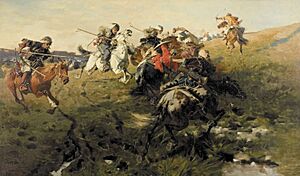
Each Kleinody item was given to a specific Cossack officer. The otaman had the bulawa. The khoruhva belonged to the whole Host but was carried by a flag-bearer. The military judge kept the main seal. The drums were kept by the drummer. All Kleinody items, except the drumsticks, were stored in the Sich's church treasury. They were only taken out by special order. Sometimes, a large silver inkwell, used by the military scribe, was also considered a Kleinody.
After the Sich was destroyed and the Ukrainian Cossacks were disbanded, the Kleinody were collected. They were stored in places like the Hermitage Museum and the Kremlin Armoury in Russia. Today, no one knows what happened to many of these treasures. After the 1917 revolution, the Russian government planned to return them to Ukraine. But this never happened due to later events. Ukraine has asked Russia to return these cultural items, but no agreement has been reached.
Alliances with Russia
After the Treaty of Pereyaslav in 1654, the Zaporozhian Host came under the protection of the Russian tsar. For a long time, they had almost complete freedom. But after Bohdan Khmelnytsky died in 1657, his successor, Ivan Vyhovsky, tried to turn back towards Poland. He was worried about Russia getting too involved in their affairs. They tried to rejoin the Polish–Lithuanian Commonwealth with the Treaty of Hadiach (1658). This treaty was approved by the Polish parliament. But the Cossack soldiers rejected it. They didn't want to unite with Catholic Poland, which they saw as an oppressor of Orthodox Christianity.
The Zaporozhians kept their own separate government from the main Cossack Hetmanate. They elected their own leaders, called Kish otaman, for one-year terms. During this time, there was growing tension between the Hetmanate Cossacks and the Zaporozhians.
The Cossacks had fought for freedom from Poland in the past. Later, they were involved in several uprisings against the tsar. They feared losing their special rights and freedom. For example, in 1709, the Zaporozhian Host, led by Kost Hordiienko, joined Hetman Ivan Mazepa against Russia. Mazepa had been a trusted friend of Tsar Peter the Great. But he allied with Charles XII of Sweden against Peter I. After their defeat at the Battle of Poltava, Peter ordered the destruction of the Sich.
After Mazepa died in 1709, his general chancellor, Pylyp Orlyk, was elected as his successor. Orlyk wrote a plan for a new government. He promised to limit the Hetman's power, keep the Zaporozhians' special rights, and work towards separating the Zaporozhian Host from Russia. With the help of Charles XII, Orlyk allied with the Crimean Tatars and Ottomans against Russia. But their campaign failed, and Orlyk went back into exile. The Zaporozhians built a new Sich under Ottoman protection, called the Oleshky Sich.
Some Zaporozhian Cossacks eventually returned to Russia's protection. But their popular leader, Kost Hordiienko, strongly disliked Russia. No peace was possible until he died in 1733.
Under the Russian Empire
Over time, the disagreements between the Cossacks and the Russian government became less severe. The Cossacks traded some of their freedoms for special rights. The Ukrainian Cossacks who didn't side with Mazepa chose Ivan Skoropadsky as their Hetman. Skoropadsky wanted to keep the Hetmanate's freedom and the officers' special rights. But he was careful to avoid open conflict and stayed loyal to Russia. To help Russia's military, Skoropadsky allowed ten Russian army groups to be stationed in the Hetmanate. Cossacks also helped build and fortify Saint Petersburg, the new Russian capital. Many Cossacks died during this hard work.
In 1734, Russia was getting ready for a new war against the Ottoman Empire. Russia and the Zaporozhian Cossacks made an agreement called the Treaty of Lubny. The Zaporozhian Cossacks got back all their old lands, special rights, laws, and customs. In return, they agreed to serve under the Russian Army in Kiev. A new Sich, called Nova Sich, was built to replace the one Peter the Great had destroyed. The Cossacks were worried about Russia interfering in their affairs. So, they encouraged Ukrainian farmers escaping serfdom in Poland and Russia to settle on their lands. By 1762, Zaporozhia had 33,700 Cossacks and over 150,000 peasants.
By the late 1700s, many Cossack officers in Ukraine became part of the Russian nobility. But many ordinary Cossacks, including many old Zaporozhians, became like peasants. They managed to stay free and continued to offer safety to those escaping serfdom in Russia and Poland. This included followers of the Russian Cossack Yemelyan Pugachev. This made Russian Empress Catherine the Great very angry. As a result, by 1775, the number of runaway serfs to Zaporizhiya reached 100,000.
The Treaty of Küçük Kaynarca (1774) brought the Crimean Khanate into Russia. This meant Russia no longer needed the Zaporozhians to defend its southern border. Russia began to settle new lands, and one of these new settlements was right next to the Zaporozhian Sich. This led to many conflicts over land with the Cossacks, which often turned violent.
The End of the Zaporozhian Host (1775)
Empress Catherine the Great decided to disband the Sich on May 7, 1775. General Peter Tekeli was ordered to take over and destroy the main Zaporozhian fortress. The plan was kept secret. Army groups returning from the Russo-Turkish war, where Cossacks had also fought, were used for the operation. There were 31 army groups, totaling 65,000 men. The attack happened from May 15 to June 8. The order came from Grigory Potemkin, who had become an honorary Zaporozhian Cossack a few years earlier. Empress Catherine II explained her decision in a decree on August 8, 1775:
We want our Empire and our loyal subjects to know that the Zaporozhian Sich is now destroyed. The name of Zaporozhian Cossacks will no longer exist. Mentioning them will be seen as an insult to our Imperial Majesty because of their actions and disrespect for our will.
On June 5, 1775, General Tekeli's forces surrounded the Sich with artillery and soldiers. The Cossacks had not faced many enemies in recent years, so they were not ready for a fight. They realized the Russian army would defeat them. To trick the Cossacks, a rumor was spread that the army was just passing through their lands on its way to guard the borders. The sudden encirclement shocked the Cossacks.
Petro Kalnyshevsky, the Cossack leader, was given two hours to decide on the Empress's demand. But behind his back, a group of 50 Cossacks planned to go fishing in the Inhul River, near Ottoman lands. This excuse allowed the Russians to let these Cossacks leave the siege. About five thousand more Cossacks joined them. These fleeing Cossacks went to the Danube Delta. There, they formed a new group called the Danubian Sich, under the protection of the Ottoman Empire.
When Tekeli found out about the escape, there was little he could do about the remaining 12,000 Cossacks. The Sich was completely destroyed. The Cossacks were disarmed without much bloodshed. Their treasury and historical records were taken away. Kalnyshevsky was arrested and sent to a prison camp, where he lived to be 112 years old. Most high-ranking Cossack leaders were also arrested and exiled. However, lower-ranking commanders and ordinary Cossacks were allowed to join Russian army groups.
What Happened Next?
Destroying the Sich caused problems for the Russian Empire. Giving more special rights to the higher-ranking Cossack leaders cost a lot of money. Also, the strict rules of the regular Russian Army made it hard for many other Cossacks to join. The existence of the Danubian Sich, which could help the Ottoman Empire in future wars, also worried the Russians. In 1784, Potemkin formed the Host of the Loyal Zaporozhians. He settled them between the Southern Bug and Dniester rivers. They were very helpful during the Russo-Turkish War (1787–1792). As a reward, they were given land in the Kuban region and moved there in 1792.
In 1828, the Danubian Sich ended. Emperor Nicholas I pardoned its members. They settled on the shores of the Northern Azov Sea, forming the Azov Cossack Host. Finally, in 1862, they also moved to the Kuban region and joined the Kuban Cossacks. The Kuban Cossacks served Russia until the October Revolution. Today, their descendants are actively bringing back their culture and military traditions. About 30,000 descendants of Cossacks who refused to return to Russia in 1828 still live in the Danube delta region of Ukraine and Romania. They continue the traditional Cossack life of hunting and fishing and are known as Rusnaks.
The Legacy of the Zaporozhian Cossacks
Even though the Zaporozhian Host officially ended in 1775, it left a huge impact on Ukraine, Russia, Poland, Turkey, and other countries. The Cossacks' changing alliances have caused debates, especially in the 1900s. For Russians, the Treaty of Pereyaslav encouraged Russia to take over Ukrainian lands. It also led Russia to claim to be the only successor of Kievan Rus'. The Russian Tsar was seen as the protector of all Russians. This led to the Pan-Slavism movement in the 1800s.
Today, most of the Kuban Cossacks, who are descendants of the Zaporozhians, remain loyal to Russia. Many fought in local conflicts after the Soviet Union broke up. Now, like before the revolution when they were the Emperor's personal guards, most of the Kremlin Regiment is made up of Kuban Cossacks.
For the Polish–Lithuanian Commonwealth, the Khmelnytsky Uprising and the fall of the Zaporozhian Cossacks marked the beginning of its end. This led to the Commonwealth's gradual decline and its division by other countries in the late 1700s. The Crimean Khanate and the Ottoman Empire faced a similar fate. After many raids and attacks from both sides, the Zaporozhian Cossacks helped the Russian Army stop Turkey's plans to expand into northern and Central Europe. Like Poland, after losing Crimea, the Ottoman Empire also began to decline.
The history of the Zaporozhian Cossacks greatly influenced the idea of Ukrainian nationalism in the late 1800s. Ukrainian historians believe that the final end of the Zaporozhian Sich in 1775 was the loss of a historic Ukrainian stronghold. After the Russian Revolution in 1917, groups of Free Cossacks were formed in Ukraine to defend the new Ukrainian People's Republic. During the Soviet Union era, the nationalist side of the Cossacks was not encouraged. Instead, their role in defending Russia from the Turks was celebrated. In 1990, the Soviet government and the Ukrainian independence movement worked together to celebrate the 500th anniversary of the Zaporozhian Sich.
Zaporozhian clothing, songs, and music became part of official state dance and music groups. They helped shape how Ukraine was seen in the future. Since Ukraine became independent in 1991, people have tried to bring back the Cossack way of life. This includes focusing on politics, horsemanship, and cultural activities. In 2016, Cossack songs from the Dnipropetrovsk region were added to the UNESCO list of cultural heritage needing urgent protection.
Today, the Zaporozhian Cossack stronghold of Khortytsia is seen as a symbol of Ukrainian statehood.
See also
- Cossack host
- Crimean Khanate
- Dmytro Yavornytsky
- Hetmans of Ukrainian Cossacks
- Khmelnytsky Uprising
- Kuban Cossacks
- Reply of the Zaporozhian Cossacks
- Sloboda Ukraine
- Zaporozhian Sich


